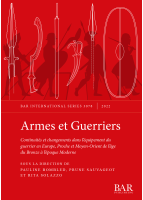Description
Ce manuscrit est le résultat d’un colloque consacré à l’armement, thématique au coeur de nombreuses recherches internationales, mais manquant parfois de visibilité. Il vise à proposer une vision renouvelée et des approches originales pour l’étude des Armes et des Guerriers en Europe et au Proche-Orient pour les sociétés anciennes. Au travers d’approches “classiques” et de la mise en place de nouvelles méthodologies, les différents auteurs s’ouvrent à des problématiques militaires, mais aussi plus sociétales, comme la façon de faire la guerre, les élites guerrières, la composition des armées, le statut du guerrier, du soldat, etc. En résumé, comment, au travers de l’étude de l’armement, peut-on comprendre les sociétés et leur mode d’organisation ? Les différents exposés de ce manuscript abordent plusieurs aspects de la recherche afin de caractériser les facteurs qui pourraient être à l’origine de modifications ou au contraire d’une pérennisation dans l’équipement du guerrier et dans ses modes de combat. Par ces différents articles, le lecteur est invité à confronter et comparer les méthodes employées pour étudier la panoplie militaire et les résultats obtenus. Ainsi, l’évolution de l’armement est abordée d’un point de vue technologique autant que typologique, sociologique et identitaire.
This manuscript is the result of a colloquium devoted to armament, a theme at the heart of international research but sometimes lacking in visibility. It aims to propose a renewed vision and innovative approaches for the study of weapons and warriors in Europe and the Near East for ancient societies. Through "classical" approaches and the implementation of new methodologies, the various authors explore military issues, but also more societal ones, like the way of making war, warrior elites, the composition of armies, the status of the warrior, the soldier, etc. In short, how, through the study of armaments can we understand societies and their mode of organisation? The various contributions in this book address several aspects of research characterising factors that influence changes or continuation in the equipment of the warrior and in modes of combat. Through these different articles, the reader is invited to compare and contrast the methods employed to study the military panoply and the results obtained. Thus, the evolution of weaponry is approached from a technological, typological, sociological and identity-based point of view.
EDITORS
Après avoir suivi un cursus en Histoire de l’art et archéologie, option archéologie à l’Université Paris Nanterre, Pauline Bombled a débuté une thèse d’archéologie portant sur l’étude des lances mise au jour en Gaule datées de l’Antiquité tardive, sous la direction de monsieur Paul Van Ossel.
After studying Art History and Archaeology at the University of Paris Nanterre, Pauline Bombled began a thesis in archaeology on the study of spears found in Gaul during Late Antiquity, under the supervision of Paul Van Ossel.
Prune Sauvageot est doctorante à l’Université Paris 1 Panthéon Sorbonne. Sa thèse porte sur l’émergence des états gaulois au travers de l’étude de l’évolution typologique, chronologique et technologique des armes datées 2nd âge du Fer en Gaule. Ses travaux de recherche portent sur le passage du guerrier au soldat, soit l’émergence d’armées professionnelles et permanentes.
Prune Sauvageot is a PhD student at the University of Paris 1 Panthéon Sorbonne. Her thesis focuses on the emergence of Gallic states through the study of the typological, chronological and technological evolution of weapons dated to the 2nd Iron Age in Gaul. Her research work focuses on the transition from warrior to soldier, i.e. the emergence of professional and permanent armies.
Née à Rome 1984, Rita Solazzo, après avoir obtenu un Master 2 à l’Université de Rome La Sapienza en Protohistoire Européenne, a décroché une thèse portant sur l’archéologie des ceintures et des crochets des âges des métaux en Italie du sud à l’Université Paris 1 Panthéon.
Born in Rome in 1984, Rita Solazzo, after after graduating at the University of Rome La Sapienza in European Protohistory, validated a thesis on the archaeology of belts and hooks from the Metal Ages in Southern Italy at the University of Paris 1 Pantheon.
List of contributors: Maria-Luisa Agneni, Pauline Bombled, Gianfranco Bongioanni, Delphine Cense-Bacquet, Jean-Baptiste Clais, Amaury Confais, Nathalie Couton, Jean-Patrick Duchemin, Léonard Dumont, Raimon Graells I Fabregat, Vincent Haure, Florence Maqueda, Stefano Marchiaro, Tarek Oueslati, Delphine Poinsot, Charles Pontonnier, Guillaume Reich, Thomas Salmon, Stéphane Salvan, Prune Sauvageot, Azzura Scarci, Rita Solazzo, Stefan Wirth, Quentin Zarka.
REVIEWS
‘The broad range of topics in different time and geographical areas gathered around the four chapters itself gives value to the volume. Especially interesting are the contributions addressing understudied or new areas for research.’ Dr Daniel Jaquet, Universitat Bern
‘This contribution is important because it is significant for the progress of research in a field that has long been neglected in the human sciences, the phenomenon of war. This publication offers first-hand data on weapons and their uses (archaeological, iconographic, experimental or from laboratory techniques).’ Dr Valérie Serdon-Provost, University of Lorraine











